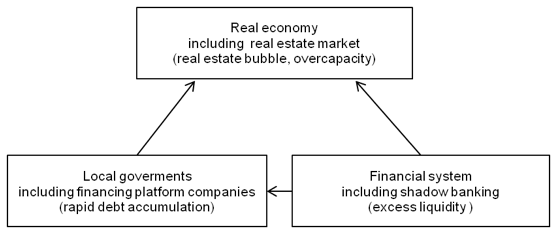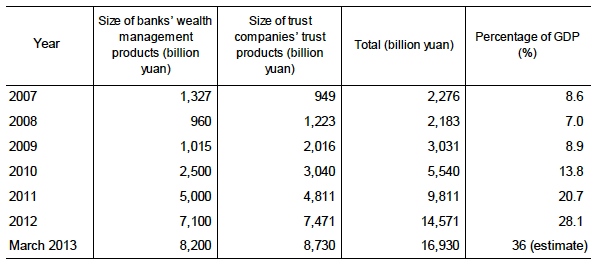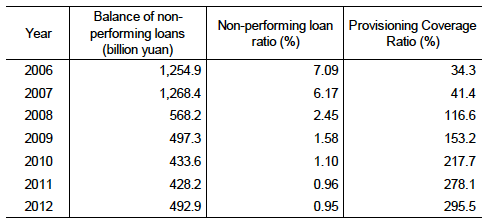In China, there is rising concern about the rapid expansion of financing through shadow banking, such as the wealth management products sold by banks and the trust products sold by trust companies. Through shadow banking, funds are flowing into the real estate market, either directly or indirectly through financing platforms of local governments, spurring an increase in housing prices (Figure 1). If this ballooning of the housing bubble is allowed to continue, the financial system will be hard hit when the bubble bursts. To prevent this risk, Chinese authorities must strengthen their supervision of shadow banking.

What is "shadow banking?"
Shadow banking is a concept that was proposed by Paul McCulley, then managing director at PIMCO, a leading U.S. asset management company, in August 2007 when BNP Paribas froze three of its funds that were exposed to the subprime mortgage market. The subprime mortgage loan problem surfaced shortly afterward in the United States, and this term became widely known.
At the fifth G20 Summit on Financial Markets and the World Economy, held in Seoul in November 2010, the participating countries agreed to ask the Financial Stability Board (FSB) to formulate proposals to strengthen the regulations and supervision for shadow banking. In response to this request, the FSB published a background paper called "Shadow Banking: Scoping the Issues" in April 2011, and began dealing with the shadow banking problem in earnest.
According to the FSB, "shadow banking" is defined as "the system of credit intermediation that involves entities and activities (fully or partly) outside of the regular banking system" in a broad sense and as "credit intermediation by non-banks" in a more narrow sense.
Although the specific content of shadow banking varies from country to country as financial systems differ accordingly, in Europe and the United States, shadow banking generally means an investment management scheme, such as asset-backed commercial paper (ABCP), conduits, or structured investment vehicles (SIVs), that employs excessive leverage to maintain margins by raising short-term funds and investing them in long-term assets. Shadow banking in Europe and the United States can be said to have been born when asset securitization made rapid progress as part of financial innovation.
The scope of shadow banking in China
In the China Financial Stability Report 2013, published in May 2013, the People's Bank of China described the scope of shadow banking in China as follows: Due to its own financial market, financial system and regulatory framework, "shadow banking" as defined internationally has yet to exist in China. However, many institutions running banking businesses but not in the name of banks are attracting attention. In light of the definition widely used overseas and the actual situation in China, shadow banking in China can be used to refer to credit intermediation involving entities and activities outside of the regular banking system, with the functions of liquidity and credit transformation, which could potentially cause systemic risks or regulatory arbitrage.
According to the report, informal financial institutions engaged in lending activities and part of the operations of financial institution in China show characteristics similar to those of shadow banking. First, informal financial institutions that provide financing include small loan companies, pawn shops, credit guarantee companies, private equity funds, rural mutual financial organizations, and various private lending institutions. Also, some off-balance-sheet wealth management products pool the cash together to achieve maturity transformation, while some trust schemes roll the short-term funds over time and again into the medium and long-term projects. Finally, money market funds, by purchasing bank debentures and investment bank deposits and participating in repurchase transactions in the financial market, help increase lending by banks and other institutions. They also provide companies with debt capital by purchasing enterprise bonds and short-term commercial papers.
However, regarding the size of the overall shadow banking system in China, official data have not been published, partly due to statistical constraints, and there has been no consensus among economists.
The Chinese Academy of Social Sciences (CASS) has proposed a narrow definition of shadow banking that only covers banks' wealth management products and trust companies' trust products (Zhang Ming, "Shadow Banking in China: Definition, Causes, Risks and Countermeasures," International Economic Review, No. 3, 2013, Institute of World Economics and Politics, CASS). According to this definition, the size of the shadow banking system in China was estimated to be 16.9 trillion yuan (equivalent to 36% of GDP) as of the end of March 2013 (Table 1).

Meanwhile, rating agency Standard & Poor's (S&P) estimated the size of shadow banking in China at 22.9 trillion yuan as of the end of 2012 based on a wider definition, including entrusted loans (when general companies lend excess funds to other companies through the intermediation of financial institutions) and private loans, after adjusting for some double counting included in each item ("Why Shadow Banking Is Yet to Destabilize China's Financial System," Standard & Poor's Financial Services LLC, March 27, 2013).
Wealth management products and trust products at the core
As just described, the specific scope of shadow banking in China is not necessarily clear. However, a near-consensus has been reached such that the wealth management products and the trust products sold by banks and trust companies, respectively, comprise the core of shadow banking.
Banks and trust companies, most of which are state-owned, are under the jurisdiction of the People's Bank of China and the China Banking Regulatory Commission (CBRC). Sales of wealth management or trust products are also subjected to their supervision.
Wealth management products are asset management products sold by commercial banks. The minimum investment amount is generally 50,000 yuan, and the maturity period ranges from one month to one year. The current annual deposit rate for one-year maturity is 3.25% for large banks, while the expected annual rate of return for wealth management products is 4%-6.5%. Most banks' wealth management products are not stated on their balance sheets, as banks do not assume the risk on their own, in general, given that the contract documents do not guarantee the principal or interest rates. Wealth management products are mostly fixed income-type products that invest in the call market, government bonds, bank debentures, enterprise bonds, and the bills of the central bank. In recent years, however, portfolio-type products that also invest in equities have come to comprise a greater share.
Trust products, on the other hand, are asset management products sold by trust companies. The minimum investment amount is normally one million yuan. The maturity period is one year or more, and the expected annual rate of return is around 9%. The investment destination mainly includes government-led basic industry (comprising 25.8% of total investment in the first quarter of 2013), industrial and commercial enterprises (27.8%), and the real estate industry (9.4%) (China Trustee Association, "The Main Business Data of Trust Companies at the End of First Quarter 2013"). Among these products, bypass loans through trust companies to avoid regulations on real estate-related loans are considered to be a particular problem.
As represented by these products, the shadow banking system in China is similar to that in Europe and the United States in the following respects: (1) it serves the function of maturity transformation; (2) it has become a tool to avoid regulations; and (3) liquidity crises due to massive withdrawal of funds may occur, as the shadow banking system is not supported by the deposit insurance system or the discount window of the central bank. However, the shadow banking system in China is also very different from that in Europe and the United States, as the latter are (1) led by non-banks; (2) have a high securitization rate; (3) have a high leverage rate; and (4) purchases are mostly made by institutional investors, whereas the former (1) is led by commercial banks; (2) has a very low securitization rate; (3) has a low leverage rate; and (4) purchases are mostly made by individual investors (Zhang Ming, "Shadow Banking in China").
Factors behind the rapid expansion of shadow banking in China
The rapid expansion of shadow banking in China is possibly the result of financial innovation to meet the needs described below regarding procuring, investing, and intermediating funds.
First, looking at the rapid expansion of shadow banking from the viewpoint of procuring funds, the real economy started to face a shortage of funds in mid-2010 as monetary authorities shifted their policy to tightening. The serious lack of financing in the real estate industry (which has been the focus of a macroeconomic adjustment), the financing platforms of local governments, and small and medium private enterprises have encouraged the sharp growth of shadow banking.
Second, from the viewpoint of investors, shadow banking provides new investment products other than bank deposits, equities, real estate, foreign exchange, etc. These new products, which provide a higher rate of return than the maximum bank deposit rates, are attractive to investors.
Third, for financial institutions that serve as the intermediaries for funds, shadow banking is a tool for avoiding supervisory management regulations through financial innovation. Banking authorities have established interest-rate regulations and relatively high reserve requirement ratios (20.0% in the case of large banks as of July 2013), and regulate bank lending through the loan-to-deposit ratio (75%) and window guidance, etc. As market competition has intensified, banks have come to use shadow banking as a tool for expanding lending in lieu of traditional channels in order to avoid regulations (Note).
Thus, while the rise of shadow banking in Europe and the United States is the result of the use of asset securitization technologies, in China, it has been complementing the function of banks as credit intermediaries, which has been weakening, mainly due to tightened monetary policy and financial regulations.
Risks involved in the expansion of shadow banking
However, as the People's Bank of China points out in the aforementioned China Financial Stability Report 2013, the risks involved in shadow banking could increase unless they are put under proper supervisory control.
First, the effectiveness of macroeconomic policies and financial supervision may decrease. Some financial institutions that have shadow banking functions continue to invest funds in the financing platforms of local governments; the real estate industry; and industries with high contamination, heavy resource consumption, and excess investment, despite the government's intention to make structural adjustments. In addition, they could induce a moral hazard and adverse selection by hiding the problem of bad loans by making up for any losses.
Second, because the fund sources and operations of the shadow banking business are intricately entwined with those of regular financial institutions, the risks could have repercussions on other industries and markets unless an effective firewall is constructed.
Third, shadow banking can adversely impact the management of regular financial institutions. To acquire customers, some shadow banking institutions promise a rate of return significantly higher than bank deposit rates which could result in funds flowing out of banks.
Finally, informal financial institutions that carry shadow banking functions, such as certain small loan companies, pawn shops, and credit guarantee companies, are increasing their lending volume by ignoring rules and risks. Due to the lack of proper oversight from authorities, operating beyond the business lines has become widespread.
With these risks in mind, the People's Bank of China has made the following proposal: "We must reasonably determine the scope and level of supervisory management to combat the problems and potential risks in the development of shadow banking. We must prevent local and systemic risks by building a diversified, multi-layered financial system that focuses on developing statistics to determine actual conditions and promoting continued financial reform, including the liberalization of interest rates."
Above all, the central bank pointed out the importance of strengthening the supervision of shadow banking by drawing on the experiences of other countries.
First, for financial institution engaged in liquidity transformation, capital and liquidity requirements should be imposed accordingly, and disclosure should be enhanced to improve transparency.
Second, a sound firewall between shadow banking and the regular operations of financial institutions should be built to segregate risks.
Third, the supervision of small loan companies, pawn shops, and credit guarantee companies should be reinforced by imposing controls on lending routes and the loan ratio, and restricting the leverage ratio.
Fourth, the scope of financial statistics should be expanded to cover shadow banking.
Fifth, information sharing and cooperation among supervisory authorities should be enhanced.
Will shadow banking cause a financial crisis in China?
There are concerns that the expansion of shadow banking in China could cause a financial crisis due to the emergence of systemic risk, as in the subprime mortgage loan problem that occurred in the United States. However, this does not seem to be a strong possibility, for the following reasons:
First, although the size of shadow banking is increasing, it is still small compared to existing bank lending. As the leverage ratio is low, market turmoil due to deleveraging also will likely be avoided.
Second, the probability that various shadow banking schemes will go broke does not appear to be very high in general, although there are some exceptions. Even if this occurs, banks typically are not responsible for compensating customer losses.
Third, as the financial condition of banks is strong, if a loss is generated from shadow banking-related businesses, it can be covered with shareholder equity and asset impairment provisions. For commercial banks in China, profit after-tax was 1.24 trillion yuan, return on equity (ROE) was 19.8%, and the capital-adequacy ratio reached 13.25% in 2012 ("CBRC 2012 Annual Report," China Banking Regulatory Commission). At the same time, the percentage of non-performing loans was only 0.95%, while the provisioning coverage ratio reached 295.5% (Table 2).

Fourth, as most banks are state-owned, the government will likely step in to provide support in times of crisis.
Fifth, the authorities have already taken actions such as tightening regulations to curb the expansion of shadow banking along with the proposals mentioned above. Although these policies will dampen the economy in the short term, they are expected to help avoid a financial crisis.
Finally, as capital flow is restricted in China, the renminbi is less prone to becoming a target of speculation. At the same time, even if a crisis happens, it is unlikely to have direct repercussions overseas.
Lately, domestic and overseas media have primarily regarded the rapid expansion of shadow banking in China as a risk factor. However, it should be recognized that shadow banking is part of the process of shifting from indirect financing, in which banks play the intermediary role, to directing financing, where the market connects borrowers with lenders, and that this shift will improve the efficiency of fund use. How to maximize the benefits of shadow banking while controlling the risks involved in it will be one of the most important issues for future financial reform. Toward that end, shadow banking should be properly supervised, rather than simply being cracked down.


